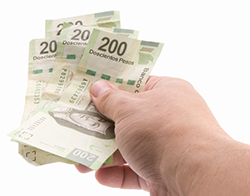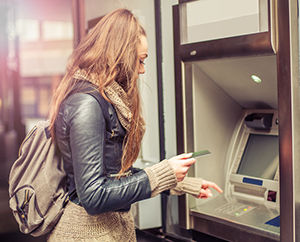Where to Get the Best Exchange Rate for Pesos
- Last Updated: March 31, 2022 by Ann & Ron Reid
- Categories:
- Peso, Tips
Mexican Money Matters
 So, you're going to México for vacation. In addition to planning where you'll stay and what you're going to do, you probably have questions about money. Can you use your credit/debit cards? Should you get pesos prior to leaving home, or exchange dollars for pesos once you arrive? Do you even need pesos or is it better to use dollars? Are dollars accepted? What is the best way to get pesos, should you decide you want them? Below we have answers for you and give you dollar smart tips on paying for goods and services while in México.
So, you're going to México for vacation. In addition to planning where you'll stay and what you're going to do, you probably have questions about money. Can you use your credit/debit cards? Should you get pesos prior to leaving home, or exchange dollars for pesos once you arrive? Do you even need pesos or is it better to use dollars? Are dollars accepted? What is the best way to get pesos, should you decide you want them? Below we have answers for you and give you dollar smart tips on paying for goods and services while in México.
Cash is King
In México, cash is still king. While most resorts and shops/restaurants in tourist areas will accept your credit/debit cards, if you venture off into more rural areas, the small shops and restaurants usually want cash. They do not have the means to be paying the credit card companies their cut of the sale. So be prepared to pay for most things, except for hotel rooms and tours, with cash.
Another thing to be aware of is some credit cards have large foreign transaction fees. Check on your card to see what the charges are should you use it abroad. There are some out there that do not have these fees and those are the better cards for traveling abroad.
Currency Condition
Watch the pesos being handed to you. Do not accept any torn or marked bills. Once they're in your hand, you will be unlikely to get the merchant to take them back. In México, you need to bring any torn or marked bills into a bank to exchange them for an undamaged bill. Merchants will not accept them.
Should you decide to use dollars, the same is true. Your dollars need to not be torn or marked. The newer the better.
Pesos or Dollars?
When traveling in México, it is best to plan on using the national currency, the peso. Doing so will save you money, as the exchange rate offered by merchants and restaurants is usually not favorable. Also, there are large areas in México where dollars simply are not accepted as the locals have no way to exchange them for pesos. While most of the highly touristed areas will accept dollars, the smaller towns are not set up to accept them.
Pesos are accepted throughout the country by law. In fact, by law, all prices must be listed in pesos and include tax. Prices can also be listed in other currencies but must be available in pesos as well. Businesses must accept pesos. While they are allowed to accept other currencies, they are precluded from demanding payment in another currency.
Pro Tip:
Before embarking on your trip, get a rough idea of how much a given number of pesos equals in your own currency. Then you will be able to quickly calculate the cost of something. For instance, at the current time, $1 USD equals about $20 pesos (they use the same symbol). So $200 pesos is approximately $10 USD, $1,000 pesos is approximately $50 USD, and so on.
The Best Ways to Get Pesos for Your Trip
ATM Machines
 ATM machines in México are called a "cajero automático," or just "cajero" (remember the "j" is pronounced with an "h" sound). Using an ATM is probably the easiest/cheapest way to get pesos once you are in México.
ATM machines in México are called a "cajero automático," or just "cajero" (remember the "j" is pronounced with an "h" sound). Using an ATM is probably the easiest/cheapest way to get pesos once you are in México.
- Spanish/English directions: Most ATMs in México have their directions in both Spanish and English and work the same as back home.
- Bank lobbies are safest. The safest ATMs to use are in bank lobbies followed by the ones in grocery/big box stores. The least safe are the stand-alone ATMs.
- Stay alert. Keep aware of your surroundings anytime you're using an ATM, in México or anywhere else in the world.
- Four-digit PIN. Your PIN should be four digits. Not all ATMs in México are set up to accept longer PINs.
Here are a few things you need to know for trouble free ATM access.
- Alert your bank. Prior to leaving on your trip, call your bank (or go online) and alert them that you will be traveling and tell them where you are going. This will avoid having a "security hold" placed on your debit or charge card when you try to use it from an unfamiliar location. Should this happen to you, there is a phone number on the back of your card that you can call to get the hold released.
- Know your bank fees. As you no doubt know, when you use an ATM that isn't owned by your bank, you get charged a fee by both your bank and the owner of the ATM. This fee varies by bank. There are a few banks that refund the ATM fees when you use an ATM other than theirs. For example, Charles Schwab, USAA, and Capitol One 360 all offer ATM fee refunds with their debit cards. When you consider the fee can sometimes be several dollars, it adds up.
- Decline the suggested conversion rate. If the ATM asks you to accept a conversion rate, DECLINE the conversion. This is a bank maneuver intended to put more money in their pockets and less in yours by giving you a less favorable rate of exchange. If you decline the suggested rate, you'll still get your money, but your bank will set the exchange rate, which will be closer to the rate banks pay.
- Do not flash your money. Do not stand at the ATM and count your money after the machine dispenses it. Discretely put your money away and step away from the machine. If you need to count your money, do so in private, away from other people. Do not flash money around in México.
While ATMs are convenient and everywhere (at least in larger towns), the tried-and-true methods of converting your money to pesos also still work.
Your Hometown Bank
If you plan ahead, you can buy pesos from your bank. Depending upon your bank and where you are, they may or may not have pesos on hand, but they can order them for you, which usually takes a few days at most. Ordering through your bank gives you a good exchange rate and assures you that you are getting valid currency. As a bonus, some banks even offer discounts for online or mobile foreign currency purchases and will deliver to your home for free. Check your bank's website or call them for more information.
You probably won't want to take out a large dollar amount in pesos from your bank, simply because walking around with a large amount of cash risks losing it or having it stolen. But if you get pesos before leaving for Mexico, you'll be assured of having cash-on-hand upon your arrival for things like taxis, tips, or refreshments. (ATMs are great until they're out of cash or down for maintenance.)
Casas de Cambio (Exchange Houses)
 Lastly, the other way to get pesos is to buy them from a casa de cambio (exchange house). A casa de cambio is a currency exchange office, oftentimes they look like booths or offices in airports and towns.
Lastly, the other way to get pesos is to buy them from a casa de cambio (exchange house). A casa de cambio is a currency exchange office, oftentimes they look like booths or offices in airports and towns.
You usually will not get the best exchange rate there and even less so at the ones at the airport. Many of these charge a commission on the amount exchanged as well as not offering the best rates. Conventional wisdom is that these are best used to exchange a small amount of left-over cash back into your home currency as you leave México. (For large amounts, your bank at home should be able to buy it back from you.)
In summary, México is still a cash-based economy so when traveling to México it's best to plan on using the local currency, the peso, to make your travel budget go further. Use a combination of your bank and ATMs to get your pesos to get the best exchange rate. Credit and debit cards can be used in most hotels and in the large tourist areas but will be more rarely accepted in the smaller towns.
Here's to getting the most bang for your buck!